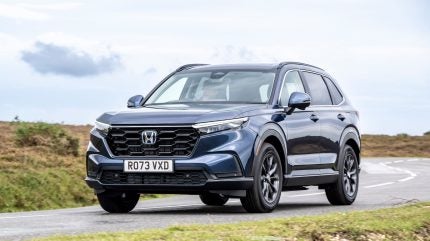
Arguably more important worldwide than the Civic, the still-new sixth generation CR-V is, shall we say, somewhat less than a highly visible vehicle in the UK. Call it a niche model produced by what had been in danger of becoming a niche brand. No more: Honda is on the rise, not just here but across the wider European region with UK-EFTA-EU sales up 64 per cent year-on-year in March.
Not an especially large vehicle, this 4.7 m long SUV is nonetheless the biggest Honda available to British buyers. And while its maker continues to be one of the world’s largest producers of IC engines (think power products, outboards, two wheelers and yes, four-wheeled vehicles), the UK market CR-V comes only in hybrid and plug-in hybrid forms.
I recently had the chance to try the e:PHEV as the official badging terms it, Honda being keen to show its electrified-as-default credentials in our region. Is it especially economical? Indeed it is, the 2.0-litre engine and two-motors powertrain returning a real-world average of 48 mpg.
Some of that excellent economy could be down to weight-saving due to this being a two-wheel drive vehicle. That’s unusual for the fact that the e:HEV (hybrid) Honda has standard all-wheel drive. Whilst AWD isn’t available for the plug-in hybrid. That decision doesn’t seem to be doing any harm to sales with a combined 957 examples sold in March. This is far from being an inexpensive model either, with the line-up starting at GBP45,930 (e:HEV) or GBP53,995 in the case of the e:PHEV.
Cold or hot conditions plus other factors which affect the claimed range of not just EVs but PHEVs too, make me cautious about manufacturers’ stated numbers. In the case of the CR-V, the maximum distance is a theoretical 50 miles but the e-PHEV was capable of about 40 with me as its driver. Not bad at all and better than some alternatives.
Visible differences between the hybrid and PHEV aren’t that significant, the main one being bespoke grilles, plus tailgate badging and the charging port. They even share the same basic mechanical package, that being an Atkinson Cycle 2.0-litre engine. Batteries are one obvious major difference, the pack of cells in the e:PHEV having a capacity of 17.7 kWh. That relatively compact size plus intelligent packaging mean the boot’s volume is 586 litres. There is a further 72 litres below the boot floor (plug-in hybrid only).
How well do you really know your competitors?
Access the most comprehensive Company Profiles on the market, powered by GlobalData. Save hours of research. Gain competitive edge.

Thank you!
Your download email will arrive shortly
Not ready to buy yet? Download a free sample
We are confident about the unique quality of our Company Profiles. However, we want you to make the most beneficial decision for your business, so we offer a free sample that you can download by submitting the below form
By GlobalDataSimilar to the dashboard of the Civic and ZR-V in some ways, the one in the CR-V is more upscale than what featured in the previous generation model. Which it does need to be when taking pricing into consideration. Standard equipment is very good too, as is the high level of Honda’s so-called Sensing safety package. That includes new features such as Traffic Jam Assist and Front Cross Traffic Warning.
Roominess, particularly for the three back seat passengers is – the company claims – best in class, and when it comes to numbers this equates to 16 mm more legroom. Opening a rear door that becomes instantly visually obvious when you see the size of the space for feet, while the windows are deep and headroom just as generous.
Seating surfaces are something else which have the premium feel to them, with quilted, dark leather featuring. These link to the gloss-black of the grille, wheels, mirror caps and roof rails. One extra distinguishing touch of the e:PHEV versus the hybrid is metal honeycomb detailing for the mesh ventilation grilles.
Honda claims this new model is more rigid in addition to being bigger than generation five. It does feel more substantial than the old model, while the eighteen inch rims give really good grip indeed considering this is a 2WD vehicle. The steering is nowhere near as precise as, say a BMW X3, but for a tall SUV there is nothing to complain about. This is also one way to tell that the CR-V is typically Honda for being lighter than most competitors.
The driver may select from six driving modes: Normal, Sport, Economy, Snow, EV and Advanced Eco-Assist. Economy works well as a default all-rounder but Sport certainly makes for better body control. And even in this, the firmest setting, ride comfort remains superb.
Summary
As an alternative to EVs, the plug-in hybrid CR-V has a lot of appeal notwithstanding what is undeniably high pricing. There again, the e:HEV is a good alternative for those thinking fifty-plus thousand pounds is too much of a stretch.
Fuel cell for US and Japan
Revealed by Honda a few weeks ago at an event in Japan, and announced by American Honda at the same time as a 2025 MY vehicle, the e:FCEV is the latest CR-V.
What makes this third hybrid special is its energy source, with both a battery and a fuel cell on board. There is a 130 kW and 311 Nm motor under the bonnet plus the same 17.7 kWh battery pack as the e:PHEV.
Two tanks below the back seat and boot hold 4.3 kilos of hydrogen. Honda’s thinking is to speed up the acceptance of FCEVs via the innovation of allowing this CR-V to also be plugged in. Thus if the driver cannot find a refueling station, the SUV can be switched to EV mode.
For now, the e:FCEV is not available in the UK, though in theory there is no reason why it couldn’t be: the Marysville plant in Ohio which builds it also producing RHD examples for Japan. Honda says the range on hydrogen is 600 kilometres plus a further 60 when in electric mode (WLTP).





